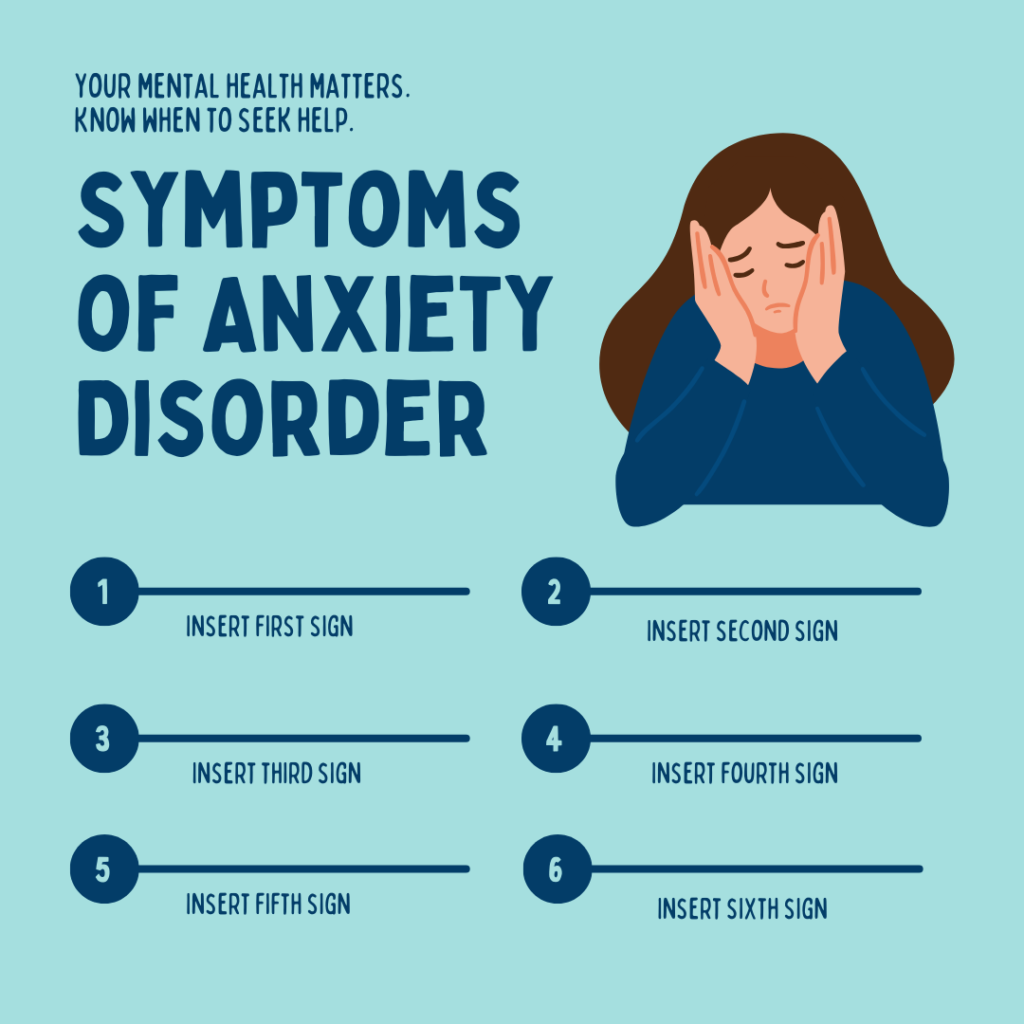Introduction
Anxiety disorders are among the most common mental health conditions, affecting millions of people worldwide. These disorders can significantly impact daily life, causing persistent and excessive worry, fear, or nervousness. At ivyleagueassignmenthelp.com we help and guide students to understand anxiety disorders, including their types, symptoms, causes, and treatment options, which is crucial for effective management and recovery.

Types of Anxiety Disorders
Anxiety disorders encompass a range of conditions, each with unique characteristics. The most common types include:
- Generalized Anxiety Disorder (GAD)
- Panic Disorder
- Social Anxiety Disorder
- Specific Phobias
Generalized Anxiety Disorder (GAD)
Generalized Anxiety Disorder (GAD) is characterized by chronic, excessive worry about various aspects of life, such as health, work, and social interactions.
Symptoms
- Persistent worrying about a variety of topics
- Restlessness or feeling on edge
- Fatigue
- Difficulty concentrating
- Irritability
- Muscle tension
- Sleep disturbances
Diagnostic Criteria
To be diagnosed with GAD, the symptoms must be present for at least six months and cause significant distress or impairment in social, occupational, or other important areas of functioning.
Causes
GAD can result from a combination of genetic, environmental, and psychological factors. Family history of anxiety disorders, prolonged exposure to stressful situations, and certain personality traits can increase the risk of developing GAD.
Treatment
Effective treatments for GAD include psychotherapy, particularly cognitive-behavioral therapy (CBT), medications such as selective serotonin reuptake inhibitors (SSRIs), and lifestyle changes like regular exercise and stress management techniques.
Panic Disorder
Panic disorder involves recurrent, unexpected panic attacks—intense periods of fear that can occur suddenly and without warning.
Symptoms
- Rapid heart rate
- Sweating
- Trembling or shaking
- Shortness of breath
- Feelings of choking
- Chest pain
- Nausea
- Dizziness
- Chills or hot flashes
- Fear of losing control or dying
Diagnostic Criteria
A diagnosis of panic disorder requires frequent and unexpected panic attacks, along with ongoing concern about having more attacks or changes in behavior to avoid them.
Causes
The exact cause of panic disorder is unknown, but factors such as genetics, major stress, and changes in brain function may contribute. Panic disorder often runs in families, indicating a possible genetic predisposition.
Treatment
Treatment options for panic disorder include CBT, which helps patients understand and manage their panic attacks, medications like SSRIs and benzodiazepines, and lifestyle adjustments to reduce stress and promote relaxation.
Social Anxiety Disorder
Social Anxiety Disorder, also known as social phobia, involves an intense fear of social situations where one might be judged or scrutinized by others.
Symptoms
- Fear of social situations
- Avoidance of social interactions
- Intense anxiety in social settings
- Physical symptoms such as sweating, trembling, and nausea
Diagnostic Criteria
To be diagnosed, the fear or anxiety must be out of proportion to the actual threat posed by the social situation, persist for six months or more, and cause significant distress or impairment.
Causes
Social anxiety disorder can stem from genetic factors, negative experiences, and learned behaviors. Overprotective or controlling parenting styles may also contribute.
Treatment
CBT is highly effective in treating social anxiety disorder, helping individuals to challenge and change their negative thought patterns. Medications like SSRIs and beta-blockers can also be beneficial, along with exposure therapy and social skills training.
Specific Phobias
Specific phobias are characterized by an intense, irrational fear of a particular object or situation, such as heights, spiders, or flying.
Symptoms
- Immediate fear or anxiety upon exposure to the phobic object or situation
- Avoidance behavior
- Physical symptoms like sweating, rapid heartbeat, and dizziness
Diagnostic Criteria
For a diagnosis, the fear must be excessive or unreasonable, persist for six months or more, and significantly interfere with daily life.
Common Phobias
- Acrophobia (fear of heights)
- Arachnophobia (fear of spiders)
- Aviophobia (fear of flying)
- Claustrophobia (fear of confined spaces)
Treatment
Exposure therapy, a type of CBT, is the most effective treatment for specific phobias. This involves gradual and repeated exposure to the feared object or situation until the anxiety diminishes. Medications are generally not used as a first-line treatment but may be prescribed in certain cases.
Symptoms of Anxiety Disorders
Anxiety disorders can manifest through a variety of symptoms, including:
Physical Symptoms
- Increased heart rate
- Sweating
- Trembling
- Shortness of breath
- Gastrointestinal issues
Emotional Symptoms
- Excessive worry
- Fear
- Irritability
- Feeling overwhelmed
Behavioral Symptoms
- Avoidance of anxiety-provoking situations
- Restlessness
- Difficulty concentrating
Causes of Anxiety Disorders
Anxiety disorders are complex and can result from a combination of factors:
Genetic Factors
A family history of anxiety disorders can increase the likelihood of developing similar conditions.
Environmental Factors
Traumatic events, chronic stress, and significant life changes can contribute to the onset of anxiety disorders.
Psychological Factors
Certain personality traits, such as high neuroticism or a tendency towards negative thinking, can predispose individuals to anxiety disorders.
Diagnosis of Anxiety Disorders
Diagnosing anxiety disorders involves a thorough evaluation by a mental health professional, including:
- Diagnostic Interviews: Structured interviews to assess symptoms and their impact.
- Questionnaires: Standardized tools to measure anxiety levels.
- Criteria: Use of DSM-5 criteria to ensure accurate diagnosis.
Treatment Options for Anxiety Disorders
Effective treatment for anxiety disorders often involves a combination of approaches:
Psychotherapy
- Cognitive-Behavioral Therapy (CBT): Focuses on changing negative thought patterns and behaviors.
- Exposure Therapy: Gradual exposure to feared situations to reduce anxiety.
Medications
- SSRIs: Commonly used to treat anxiety disorders by regulating serotonin levels.
- Benzodiazepines: Used for short-term relief of severe anxiety symptoms.
- Beta-Blockers: Help manage physical symptoms of anxiety, such as rapid heartbeat.
Lifestyle Changes
- Exercise: Regular physical activity can reduce anxiety symptoms.
- Diet: Eating a balanced diet and avoiding caffeine and alcohol can help manage anxiety.
- Sleep: Ensuring adequate sleep is crucial for overall mental health.
Alternative Therapies
- Mindfulness and Meditation: Techniques to reduce stress and promote relaxation.
- Yoga: Combines physical postures, breathing exercises, and meditation.
- Acupuncture: Traditional Chinese medicine practice that may help alleviate anxiety.
- Herbal Supplements: Some individuals find relief with supplements like chamomile or valerian root, though it’s important to consult a healthcare provider before use.
Impact of Anxiety Disorders on Daily Life
Anxiety disorders can significantly affect various aspects of daily life, including:
- Work: Difficulty concentrating, absenteeism, and reduced productivity.
- Relationships: Strain on relationships due to irritability, withdrawal, and fear of social interactions.
- Physical Health: Chronic anxiety can lead to health issues like heart disease, gastrointestinal problems, and weakened immune function.
- Overall Well-Being: Persistent anxiety can diminish the quality of life and overall well-being.
Coping Strategies for Anxiety Disorders
Effective coping strategies can help manage anxiety symptoms:
- Mindfulness Practices: Techniques like deep breathing, meditation, and progressive muscle relaxation.
- Support Systems: Relying on friends, family, and support groups for emotional support.
- Time Management: Organizing tasks and setting realistic goals to reduce stress.
- Self-Help Resources: Books, apps, and online resources that provide strategies for managing anxiety.
Preventing Anxiety Disorders
While not all anxiety disorders can be prevented, early intervention and resilience-building strategies can reduce the risk:
- Education: Learning about anxiety disorders and their symptoms.
- Resilience-Building: Developing coping skills and stress management techniques.
- Healthy Lifestyle: Maintaining a balanced diet, regular exercise, and adequate sleep.
- Early Intervention: Seeking help at the first signs of anxiety to prevent escalation.
Living with Generalized Anxiety Disorder (GAD)
Living with GAD requires ongoing management and support. Personal stories of those who have successfully managed GAD can provide inspiration and practical advice. Daily management strategies include:
- Routine: Establishing a regular routine to provide structure and stability.
- Relaxation Techniques: Incorporating relaxation practices into daily life.
- Therapeutic Support: Regular sessions with a therapist to monitor progress and adjust treatment as needed.
- Medication Management: Adhering to prescribed medications and discussing any side effects with a healthcare provider.
Research and Future Directions in Anxiety Disorders
Ongoing research aims to improve our understanding of anxiety disorders and develop more effective treatments. Emerging areas of interest include:
- Genetic Research: Identifying genetic markers associated with anxiety disorders.
- Neuroimaging: Using brain imaging techniques to understand the neural mechanisms of anxiety.
- Digital Health: Developing apps and online interventions for anxiety management.
- Innovative Therapies: Exploring new therapeutic approaches, such as virtual reality exposure therapy and transcranial magnetic stimulation (TMS).
FAQs
What are the most common types of anxiety disorders?
The most common types include generalized anxiety disorder (GAD), panic disorder, social anxiety disorder, and specific phobias.
How is generalized anxiety disorder (GAD) diagnosed?
GAD is diagnosed based on persistent and excessive worry about various topics for at least six months, along with physical and emotional symptoms that cause significant distress or impairment.
What are the main treatment options for anxiety disorders? Treatment options include psychotherapy (especially CBT), medications (such as SSRIs and benzodiazepines), lifestyle changes, and alternative therapies.
Can lifestyle changes help manage anxiety disorders?
Yes, regular exercise, a balanced diet, adequate sleep, and stress management techniques can significantly help manage anxiety symptoms.
How does cognitive-behavioral therapy (CBT) help with anxiety disorders?
CBT helps by changing negative thought patterns and behaviors that contribute to anxiety, teaching coping strategies and problem-solving skills.
What role does genetics play in anxiety disorders?
Genetics can play a significant role, with family history being a strong risk factor for developing anxiety disorders.
Conclusion
Anxiety disorders are common but highly treatable mental health conditions. Understanding the types, symptoms, causes, and treatment options can empower individuals to seek help and manage their anxiety effectively. With ongoing research and advances in treatment, there is hope for those affected by anxiety disorders to lead fulfilling lives.

